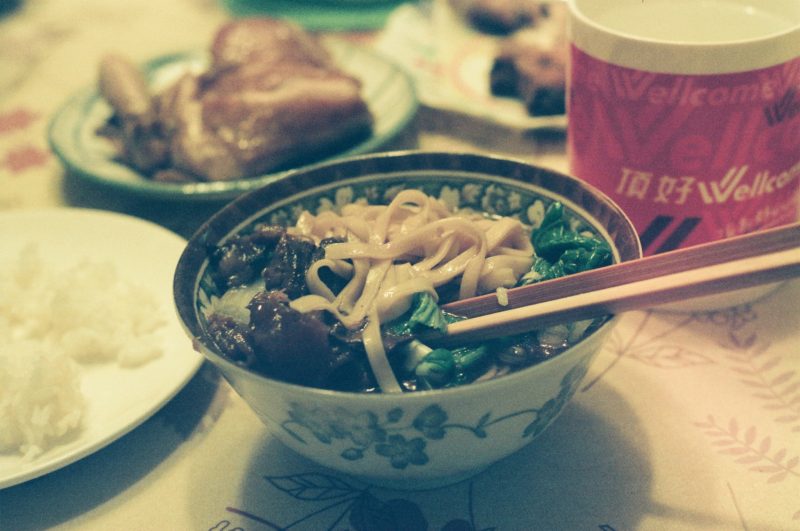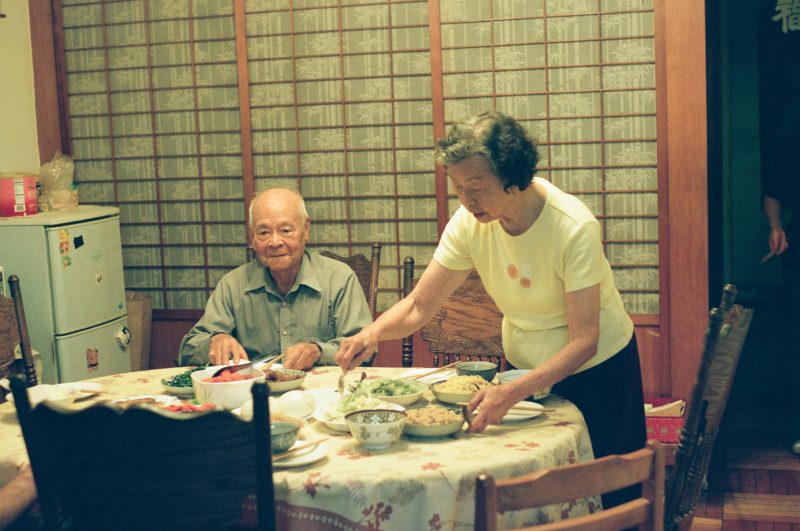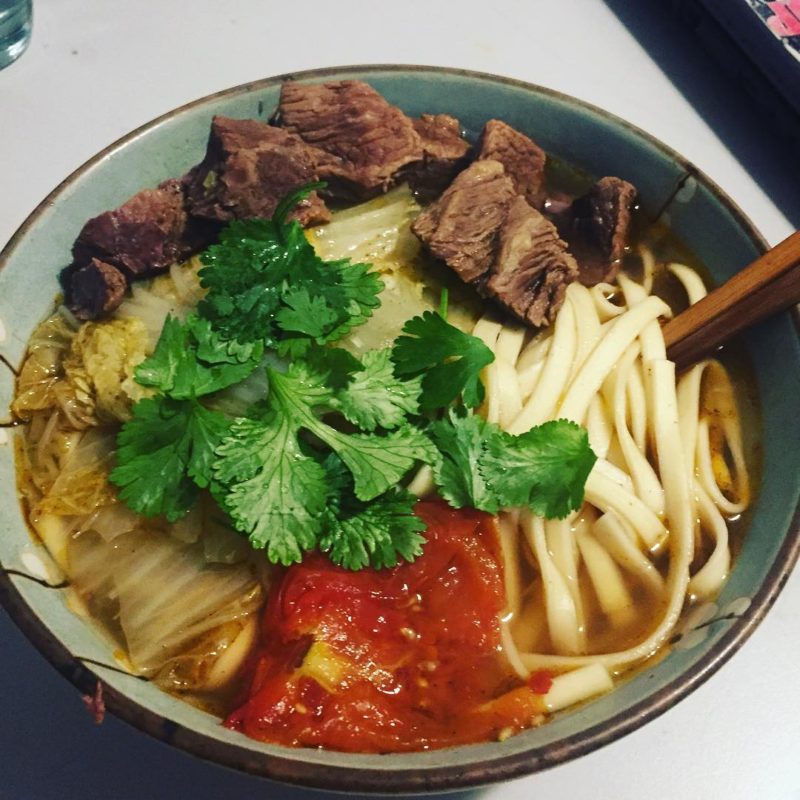In this except of this is for mẹ, Zachary Schwartz anchors us in the familiar scent of grandma’s noodle soup, and takes us on a sensory journey through time and identity as he explores the weight of his multiracial ancestry, and how he found home in food.
Inspired by Ocean’s Vuong’s letter to his mother in the New York Times, this is for mẹ lives online as a borderless mailbox for Asian identified people to share stories rooted in mothers, motherhood, motherlands, mother-tongues and family.
The Legend of The Taiwanese Beef Noodle Soup

Asian moms don’t say “I love you.”
It’s just not in the culture, but it doesn’t mean they love their kids any less. Growing up, love came to me every Sunday night in the form of a spicy, soulful, and savory broth, filled with generous cuts of beef, tomato, napa cabbage, and heaps of noodles, seasoned with anise seed, ginger, garlic, and other inflections: Taiwanese beef noodle soup.
Those four words are enough to slingshot me down a memory tunnel where, similar to the ending of Ratatouille, the entirety of my childhood experience floods like a torrent down my consciousness. Like an ant that inhales a parasitic spore and loses its autonomy, climbs up a tree, and allows its body to be used as a receptacle for the spore to reproduce, I too want to climb into my bed, curl up into a ball, and whisper those words, over and over, into the wall: “Taiwanese beef noodle soup.”
I grew up in a suburb on the west side of Cleveland. For the first ten years of my life, as a mixed-race Jewish and Taiwanese kid, I was the only religious and ethnic minority that I knew. Much of my childhood was spent wishing I was white. I remember going through a phase where I begged my parents to buy the boxed dinners, pierogis, and salisbury steaks that I associated with my “normal” Irish-American neighbors. I remember wishing that my hair was straight and my eyes were blue. I remember not having many friends.
On top of that, during the early years, my mom was not around much. She worked long hours at a high-powered law firm in Cleveland. Sometimes her only presence during the school week were lovely Post-it notes she’d fasten to a hasty paper bag lunch. Many nights my dad would cook Hamburger Helper or Hungarian noodles.
But on the weekend, the the house would fill with the wonderful aroma of Taiwanese beef noodle soup—the end result of hours of brewing beef, green onion, tomato, garlic, cinnamon, soy sauce, and other savory ingredients.

Probably immersed in some tome in my room, I would fly down the stairs, clearing four or five steps at a time as only a seven-year-old can do, breaking into song and dance at the bottom of the stairs. “Beef noodle soup! Beef noodle soup!” I’d chirp.
And when I sat down at the table, barely able to contain my excitement, and my mom brought over the steaming bowl, topped with a fresh sprig of cilantro, and I slurped down the rich, aromatic broth, the hot bubbles of beef fat spilling down my throat, all I heard and felt was “I love you.”
🍜
The East Asian relationship with food is tighter, perhaps, than any other culture on Earth. The biggest cultural export of China—a nation of a billion-and-a-half—is Chinese food. Most people around the world solely encounter East Asian culture, or its local simulacrum, through its signature dishes: pad thai, pho, sushi, ramen, bibimbap.
Chinese cuisine, with its limitless combinations of sugar, spice, and everything with rice, is one of the most floral and thriving on our planet. Chinese food derives its deliciousness, as most worthwhile things do, from adversity. It comes from a people so starved by the latest famine, flood, or empirical decree that they would have the desperation, and consequent inspiration, to combine wood-ear fungus with cilantro, frog with pickle, birds nests and red vinegar…
In East Asia, many region have their own style: of martial arts, craftsmanship, cooking. The same way American cities take pride in their own local flavor of hip-hop, different provinces of East Asia have dishes they’d love to hold up against the town down the road.
So, too, is Taiwanese beef noodle soup tied to the misty island of mountains and monkeys that is Taiwan. According to Everipedia, beef noodle soup was first concocted by a Muslim minority population in Southeast China. According to my mom, beef noodle soup arrived with Chiang Kai-Shek and his army in 1949. Defeated by the communists, armed with pots and pans, they began simmering beef noodle soup.
Over the decades, Taiwanese beef noodle soup developed a flavor of its own. Today, there are streets after streets in Taiwan devoted to the dish. When tourists come from China, they come to eat our beef noodle soup.
Taiwan, like Texas, has been ruled over by different entities in its lifespan: the Aborigines, Dutch, Qing Dynasty, and Japanese Empire. Taiwan now exists as a precarious autonomy under constant threat from the Chinese. China insists that Taiwan is part of China, a claim that has made multiple generations of my family take to the streets in protest.
The frightening monoculture of China looms over Taiwan like hurricane clouds. But we have our own history, our own culture, our own ethnic makeup—many Taiwanese have Japanese and Aborigine blood—and our own way of making beef noodle soup. It’s not just niúròumiàn, 牛肉麵 — it’s Táiwān niúròumiàn, 台灣牛肉麵.
That’s why it’s our national dish.
🍜
“He’s white.”
“He’s not white.”
I had made it to college in New York City. I was standing in a computer lab as two girls argued about me in front of me.
The girl who was telling me I was white was Indian. Perhaps it was a way to compensate for her own middling place, as an Asian in the intersectional stack, by “othering” me.
The Black girl was shaking her head and saying “He’s not white. He’s not white.” Bless her heart.
The reality is, it didn’t matter what either of them said. I knew what I was, and that’s what counted the most. But I can’t admit it wasn’t troubling. After eighteen long years, I had finally found the confidence to be proud of who I was as an Asian-American. And now someone was trying to take it away from me.

It wasn’t the only time it happened. Numerous peers in college, obsessed with race and identity politics—usually as a way to distract from their own economic privilege back home—would try to dictate who was “white-passing” and who wasn’t. I sometimes bore the brunt of that as a way to diminish my voice as a writer or rapper.
Later that semester, I went to a Chinese restaurant with a few friends. I ordered some of my favorite treats: cold jellyfish, razor clam, West Lake beef soup. One my friends observed something: “You’re very American, but you can tell you’re the child of an immigrant because of what you eat.”
My paternal side is Jewish, and I remember a story from my childhood. At the concentration camps, Allied soldiers would walk around, calling the first words of the Shema—one of the foundational prayers of Judaism—out loud. “Shema Yisrael” (Hear, O Israel). Even children who remembered little else would call back: “Adonai Eloheinu, Adonai Echad” (The Lord is God, the Lord is One).
Maybe, similarly, you can tell an Asian from their palette.
To be Asian is to be intimately connected with its food. After all, your body is what made up of what you eat. A lifetime of Asian food has presumably infused my cells with the essence of Taiwanese beef noodle soup and other delicacies.
Any Asian will tell you that food might possibly be the best part of our culture. I think of my cousins in Taiwan who are forced to endure long hours of school, then after-school “cram school,” then after-cram-school after-school. But in-between the oppressive hours, they get to dine on glorious box lunches and home cooking that puts the peas, carrots, and unseasoned beef of Anglo-American cuisine to shame.
Someone can question my identity, but I can go into the Asian market and identify every unusual ingredient or herb and parrot what my mom taught me: “This will make your eyes better. This will cure your depression.” I have my family’s recipe of Taiwanese Beef Noodle soup, passed down from my Ama to my mother to me, held close to my chest like a sapphire.
When I was younger I used to eat Taiwanese beef noodle soup. Now every weekend or so I spend the requisite hours cooking it. I slice the beef, chop ginger, and boil water. I hear my mom’s gentle instructions as I sprinkle in anise seeds. I feel the hum of ancestral memory as I wash and stack the napa cabbage. And whoever I serve it to—my friends or my girlfriend, my future wife or children—will learn about the legend of the Taiwanese beef noodle soup.
And it will be delicious.

Contributor Bio
 Zachary Schwartz is a Taiwanese-American writer from Cleveland, Ohio. He writes about hip-hop, mixed-race identity, subcultures, crime, and other topics. Some of his stories include playing chess with GZA from Wu-Tang Clan, going “on the campaign trail” with John McAfee, and participating in an ayahuasca ceremony in Mexico and discussing it with Deepak Chopra. His stories have been published in Rolling Stone, Playboy, Vice, New York Tyrant, and other magazines. He graduated from Columbia University in 2017. He also makes rap music and short films. He can be followed on Twitter, Instagram, and his website.
Zachary Schwartz is a Taiwanese-American writer from Cleveland, Ohio. He writes about hip-hop, mixed-race identity, subcultures, crime, and other topics. Some of his stories include playing chess with GZA from Wu-Tang Clan, going “on the campaign trail” with John McAfee, and participating in an ayahuasca ceremony in Mexico and discussing it with Deepak Chopra. His stories have been published in Rolling Stone, Playboy, Vice, New York Tyrant, and other magazines. He graduated from Columbia University in 2017. He also makes rap music and short films. He can be followed on Twitter, Instagram, and his website.



[…] THIS IS FOR MẸ: The Legend of The Taiwanese Beef Noodle Soup by Zachary Schwartz […]
About twelve years ago, I went on a search for niuroumian in Salt Lake City. It had been too long since I’d had any of my mom’s during a trip home to the Toronto area, and three or four years since the two tasty bowls I’d had during a week-long trip to Taipei with my sister. My craving was hitting hard.
I asked for beef noodle soup, because I couldn’t find it on the menu, at Red Maple Cuisine (which is known for its authentic Chinese food in a spacious, elegant environment for both Chinese and American diners). My waiter asked the kitchen and returned, saying that they could easily make it for me, special. But as I was waiting, I realized that if this dish — whose broth and beef takes hours to prepare — could be ready for me on the spot, it could not be the right one! And I was completely right. I got a typical noodle soup: a bowl of noodles served in a colorless broth, with slices of beef and green onions placed on top. The waiter inquired whether this was what I had wanted. I replied no, but that I would eat it. (I quietly reminded myself repeatedly that I could enjoy this noodle soup with beef in it.) He asked the cooks again, and one from the mainland said he knew of the type of niuroumien I was asking for.
It was then that I learned to ask for Taiwanese beef noodle soup. But at that time, I decided I had to continue my quest to fulfill my craving by learning how to make it myself. I searched online and created a composite recipe from overlapping ingredients from recipes on three sites. I learned that beef shank was the ideal cut to use, and to boil it for three hours. I figured out where to source beef shank (not the local grocery store chain!). I eventually tried out the recipe in an electric pressure cooker, and found it cut off less than two hours of that cooking time.
I’ve since heard that The Mandarin restaurant, a half hour drive north in the city of Bountiful, makes excellent niuroumien. And close by, a restaurant called Mom’s Kitchen was opened by two Chinese women, one from Beijing and one from Taiwan. They do make a passable Taiwanese beef noodle soup, with some pickled greens on top. But the flavor and color were still too light and not quite right. It seems to be lacking star anise.
Right by my children’s school, a small restaurant with the dubious name of Sweetie Foodie D Market has recently opened. Their Szechuan beef noodle soup is not bad, but it is small, overpriced, and arrives very slowly. There’s no way I can afford the time or cost to feed a full meal of it to my hungry family. My Southern-raised husband and two of my four sons complained the soup was too spicy for them to eat, and my husband’s good will toward this restaurant was squandered by the restless, complaint-filled wait of our children, and their subsequent fight to share the dishes I’d ordered.
It’s time to make another homemade batch of Taiwanese niuroumien. And a batch of jiaozi.